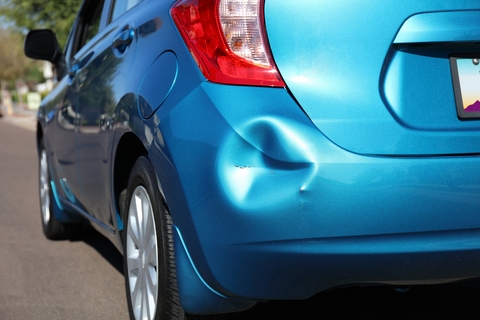Don't let minor dents, scrapes ruin the value of your car

A relaxing summer day can turn sour in a hurry when you return to your vehicle and notice some new imperfections on its shiny exterior.
“Dents and dings are particularly annoying because they show up like spots on a mirror, especially on dark colored surfaces,” said Chuck Sulkala, executive director of the National Auto Body Council. “They also can diminish the value of your vehicle.”
Yet, you may not have to choose between an expensive repair and learning to live with a scar on your paint job. Paintless dent repair offers an alternative to body shop repair for dings or small dents.
“Paintless repair may be done just as effectively and seamlessly as a regular repair and can thereby maintain the original factory finish,” Sulkala said.
Body shop repairs traditionally involved sanding, masking, priming and painting. The work is laborious and may not be cost-expensive for something as small as a door ding.
Doors, hoods, fenders and trunks typically sustain the most damage and are prime candidates for paintless dent repair. The areas are typically made of thin, pliable metal and are easy to access.
Scraped paint or dents can leave metallic surfaces exposed, inviting rust and corrosion to cause significant and expensive problems in the future. Damage needs to be addressed before it becomes a worse problem, Sulkala said.
“No one likes to spend money especially on very minor repairs that were not of their doing,” Sulkala said. “But to not take care of that minor damage simply jeopardizes the value of the vehicle.”
It takes an expert with a keen eye to do the work properly, Sulkala said. The technician must finesse the metal then apply the right pressure to the exact spot in order to achieve the best result.
“The process is more of an art skill than the use of machines and tools to do the work,” Sulkala said.
Paintless dent repair may be used on a wide variety of dents, as long as the sheet metal is not stretched or the paint chipped.
Sulkala offered the following guidelines for vehicles with apparent minor dent repair:
- Location of the dent determines repair options. Trunks, all side panels, roofs and hoods are the best candidates for repair.
- Check for chips and scratches that expose the surface metal. Surfaces must be repainted even if dents are removed. Otherwise, water may interact with the metal and cause rust.
- Use a paintless dent repair specialist and get references and proof of insurance before work begins.
- Consider removing dents and dings before trading in your vehicle. It may improve resale value.
- Avoid paintless dent repair for parts made of plastic or metal composite. Those types of components cannot be fixed by paintless repair.
- Do not use paintless dent repair on stretched panels and dents on panel body line creases. In most cases both problems require traditional auto body repair.
- Ask your service advisor for assistance finding the right dent repair specialist.
“Put your vehicle in the hands of someone you trust,” Sulkala said. “Make sure your collision repair specialist is as competent with your vehicle as your doctor is with working on you.